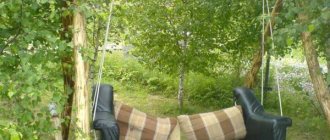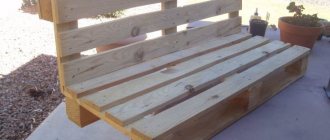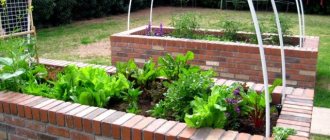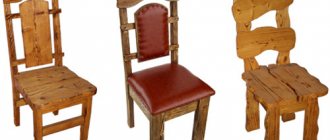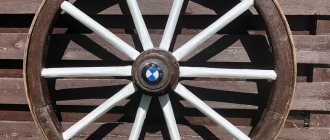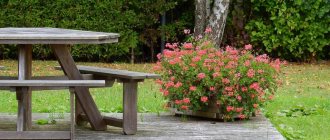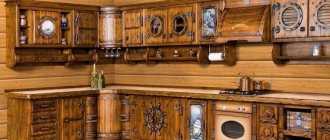A special bench will simplify work in the garden - weeding, loosening and planting plants. This folding design will eliminate the need to kneel on the dirty ground. Thanks to this, your back will be less tired, because the lower back often suffers due to an uncomfortable position. It’s quite easy to create a universal garden bench with your own hands from scrap materials - no special tools or special skills are required for the work. The folding design is used as a stand while working, as well as a bench for relaxation.
How to make a universal bench for the vegetable garden with your own hands
Periodic gardening work is an obligatory part of the workday of owners of dachas and personal plots. But keeping the plantings pleasing to the eye clean and tidy is quite hard, tedious work. From being in a bent position for a long time, my lower back hurts and my legs hurt. And kneeling on the ground, which is not always flat and dry, is unpleasant. A universal bench for the garden will be an excellent assistant in this case - it’s quite simple to make a convenient “changeover” with your own hands, which will facilitate the processes of weeding, loosening and planting. Such products are very popular among gardeners, because with a minimum of labor and financial costs, they make it easier to care for the land, while ensuring a comfortable back position.
Knee pads
Probably the simplest and most budget option. They protect joints from cold, dampness and injury, making work more comfortable. The main thing is to choose a comfortable model so that it fits your feet, as they say. I haven't been able to find one yet, unfortunately. Although I think I would use the idea from the following short video...
A pocket for a knee pad on work trousers easily and elegantly solves the problem that for me personally has become the main obstacle to using these devices - the way they are attached: the straps put pressure on the leg, causing considerable discomfort and causing swelling.
If you fix it too loosely, the structure simply slides. However, I know summer residents who found the purchased knee pads to be just right and really liked them. By the way, among the seven-dacha residents there are also such: Super knee pads from Seedspost.ru. Perhaps, over time, I will find “my” option... A wide range of knee pads of various models for gardening and construction work is presented in our catalog, which combines offers from large gardening online stores. View a selection of knee pads and choose the ones that suit you .
Design advantages
The design of such a bench is quite simple. The two supports on the sides are solid, stable legs that will not sink even into wet or loose soil. And the inverted bench turns into a comfortable soft knee rest or hand rest for working in the garden.
The product, designed to perform numerous manipulations with the soil in the country or in the garden, is surprisingly multifunctional. On it you can:
A DIY upside-down garden bench will become a reliable assistant when performing many activities. With its help, any work in the garden is greatly simplified, including:
Simplicity of execution and wide scope of use determine the increasingly growing popularity of the chair for working in the garden. An inverted bench makes it much easier to carry out daily care of plants and the territory.
Manufacturing process: step-by-step instructions
Before making the product, the wooden parts must be measured, sawn to size and sanded so that they are smooth and without burrs.
Choose hard species - for example, birch or pear, so that the product will last longer.
Let's look at an example of the implementation of the simplest design option - making a chair with a back and seat made of slats.
To make a piece of furniture you will need wooden blocks.
Making a folding chair begins with making the seat. We connect the sized slats to the support bars using self-tapping screws.
For a wide seat and backrest, you may need a solid board (or chipboard).
Then you need to make a support structure from the front legs and back. Attach slats for the backrest to the legs on top, and a crossbar at the bottom.
A folding chair can be beautifully decorated to give it a personalized look.
After this, make the back supports. It is necessary to attach two crossbars to them - lower and upper.
Let's look at an example of the implementation of the simplest design option - making a chair with a back and seat made of slats.
Connect both resulting frames - rear and front - using nuts and bolts.
A chair you made yourself can be decorated using the decoupage technique.
Attach the seat to the front frame. Drill through holes in it and the seat supports. Connect the structure with bolts. All fasteners that extend to the surface of the back or seat must be “recessed” so that they do not stick out.
Attach slats for the backrest to the legs on top, and a crossbar at the bottom.
If the process is performed correctly, the seat will move freely in the frame. When unfolded, the rear of the seat rests against the crossbar of the rear frame. Thus, you will get a full-fledged chair that can be easily returned to its original position.
Before making the product, the wooden parts must be measured, sawn to size and sanded so that they are smooth and without burrs.
The reverse order of folding the chair requires raising the seat slightly and assembling the front and back frames.
It is necessary to make a supporting structure from the front legs and back.
After work, check the product for stability. You can place the furniture on the balcony or large kitchen. The chair is convenient to take with you on a picnic or to the country house.
If you plan to make the chair yourself, then prepare a free space for the work and place oilcloth or thick paper so that the process goes smoothly.
Product dimensions
Having decided to make a bench with your own hands, you need to decide what dimensions are needed. A standard bench for a summer residence, without individual modifications, has the following dimensions:
When creating an inverted garden bench with your own hands, you can approach the process creatively, changing the standard sizes according to your individual needs. For example, make the legs higher if the owner is tall and would find it uncomfortable to sit on a low chair. You can also lengthen or widen the seat, depending on the size of the person who will use the product, or for greater comfort. If the structure is assembled with your own hands from hollow tubes, then the main weight of the bench for working in the beds falls on the seat. In this case, it is quite possible to increase its size without significant weighting. Even if you add another 30 cm to the standard dimensions, the weight will remain virtually unchanged. If the garden inverted chair is made of wood or chipboard, any significant increase in size can affect the overall weight of the structure, which will make it inconvenient to carry and too bulky.
When determining the dimensions of a structure to create with your own hands, gardeners should consider what material it will be made from.
From water pipes
Paying tribute to modern trends, you can set up production from recycled materials. If desired, you can use a variety of materials, even quite extraordinary ones, which will allow you to produce unique metal interior items. An example of such a product would be a table for which water pipes were used as legs.
The tabletop for such a table can be made of wood or glass - in any case, it will look exclusive. Sufficient strength, at the same time, can guarantee its long-term use.
The manufacturing process can be divided into several stages:
- Development of a drawing taking into account all the necessary parameters.
- Calculation of the required amount of material and components.
- Purchasing everything needed for work.
- The actual production.
Knowing some little tricks, you can turn such a table into a work of art. For example, painting pipes with a noble black color will give you a retro effect. Aerosol paint for metal is suitable for such purposes - it is sold in any auto or hardware store.
A wooden tabletop must be coated with several layers of varnish. If you also use stain, you can give the wood the desired shade.
Such a table, made by yourself, can have any size - it all depends on your desire and need. You can make both a dining table and a coffee table from metal.
Materials and tools
Without a doubt, every summer resident, home craftsman or simply zealous owner will have in stock cuttings of boards, thick plywood or the remains of polypropylene pipes. It is quite easy to find raw materials from which you can make a garden bench for weeding in the dacha farm, in exactly the proportions that are needed. Examples of materials that gardeners can use to make a bench with their own hands, the features of their influence on the final weight of the product, the pros and cons are presented in the table.
Affordable, durable, and with proper care will last a long time
Wood is afraid of dampness and moisture, so there is a risk of swelling and rotting if used and stored improperly
Depends on the type of wood and the degree of dryness. Well-dried pine or linden boards are light, the wood is quite soft
No special skills required, just the simplest tool needed
Materials pick up moisture very quickly and swell. The plywood begins to delaminate, and the chipboard begins to crumble. Less durable than other options, capable of deformation from gravity
The heaviest materials that can be used to make a standard size high chair
Hollow polypropylene tubes
Easy to process, as a rule, trimmings remain from repairs or construction and do not require special conditions for operation
A plumbing soldering iron is required
The lightest material possible. You can create a bench of any size that is convenient, it will have little effect on the weight
A universal garden bench is easy to make with your own hands, you just need to put in a little effort. In addition to the necessary raw materials, you will also need tools. Basically, you take what is at hand: a hand saw or a grinder, a jigsaw, a drill for drilling holes. To work with plastic tubes, you will need a hacksaw for metal, as well as a plumbing soldering iron.
When working with tools, you must protect your hands with gloves and your eyes with goggles to avoid injury.
Helper bench for vegetable garden made of polypropylene pipes
A simple upside-down bench made of polypropylene pipes.
My wife asked - I did it. We take pipe d32 - it seemed to me that it would be the strongest - 2 pieces of 2 m each. * 143 rubles / piece = 286 rubles. tee d32-8 pcs.* 21 rub./pc.=168 rub. corner d3 90 degrees - 8 pcs. * 7.6 rub./pc. = 60.80 rub. Total=514.80 rub. Next we cut according to size:
6 pcs.-240mm.
6 pcs.-145mm. 4 pcs.-345mm. 4 pcs.-30 mm. Usually such things are cut with special scissors, but I didn’t have any and I used a hacksaw for metal - it worked perfectly. Using a plumbing soldering iron, we solder all the parts together.
We saw off 2 pieces of plywood to size and fasten them with self-tapping screws, having previously drilled holes for them in the fastening points - otherwise the polypropylene has a chance to split later - it is not intended for screwing self-tapping screws into it...))) We glue a soft material on top - I used an old foam travel mat — I glued 2 layers to the seat, 3 layers to the kneerest, glued it for the usual “moment”. Then my wife sewed a removable cover so that it could be washed. Everything, not counting the glue drying time, took me no more than 3 hours. Become the author of the site, publish your own articles, descriptions of homemade products and pay for the text. Read more here.
How to make it yourself
The process of making a bench for weeding beds will not take much time. First you need to decide on the materials. Then you can begin the labor process. To make a simple wooden bench you will need:
Two trapezoidal legs are cut out from boards of suitable width with a difference between the upper and lower parts of about 10 centimeters. For example, the top element can be 25 cm wide, the bottom - 38. If the width of the boards is not enough, the sidewall parts will have to be additionally attached to the transverse strips at the top and bottom. The height of the sidewalls is usually 50 cm and above. Work algorithm:
You can also build a bench for weeding beds from small boards of hard wood. In this case, instead of a solid seat and sides, the structure is assembled from separate slats. A stool made with your own hands should be carefully varnished or painted to protect it from exposure to dampness, dirt and insects.
For a better understanding of how to make a weeding chair with your own hands, it is worth first studying the diagrams and design drawings presented on numerous thematic sites.
To make a high chair from polypropylene tubes, you will need:
First you will need to cut the pipes with a hacksaw according to this pattern:
Solder the middle from two pieces of 24 cm and six pieces of 14.5 cm. Then solder the upper handrails-legs to it, from two tubes of 24 cm, and then the sidewalls - 34.5 cm each, and the lower handrails-legs. Screw cut-to-size plywood onto the bottom and top. For softness, you can sew or glue any porous material onto it.
The final dimensions of the product made according to the above instructions will be:
This simple design has a number of advantages: it is lightweight, does not require special storage conditions, painting, and is not subject to corrosion and rotting. If necessary, the dimensions of a universal bench for a vegetable garden with your own hands can be changed at will without compromising the strength or weight of the product.
Additional equipment
For ease of use, the bench can be equipped with various useful little things. Here imagination and consideration of personal needs will come to the rescue:
To soften the seat mat, pieces of tourist foam, synthetic padding, polystyrene, holofiber, struttofiber, and other synthetic padding materials can be used.
As you can see, the simplicity of the design will make it easy to create a “shifter” yourself. Such a homemade weeding chair will remain a useful and necessary household device for a long time, and its use in the garden will help save strength and health.
Why do you need a chair for weeding beds?
Using a bench may seem like an outlandish quirk or whim, but in practice such a chair makes it possible to do weeding while being in more or less comfortable conditions in two positions:
Two options for using the chair
At first glance, weeding in this position can be done without a bench; it can be replaced with a polypropylene mat or just a small plywood board. In reality, such an inverted bench, photo, has one undeniable advantage in the form of side rails.
If the bench has two side posts, then getting up from your knees and, accordingly, rearranging the shifter and moving on to weeding is much easier than if it was just a plywood board.
Examples of homemade furniture
Homemade products based on PVC or polypropylene have a number of objective advantages. Such designs fit perfectly into a loft-style interior.
In fact, the use of water, heating and sewer pipes is much more extensive than you might imagine. Everything is limited solely by your imagination. Turn on your imagination, look at the photos of finished products, and start creating.
Let's look at some interesting solutions. There is no way I can cover the entire range of crafts, but I will highlight the designs that most attracted my attention:
Types of chairs for weeding beds
It is clear that it is necessary to design and make a bench for working in the beds with your own hands, taking into account your own anatomical parameters, such as weight, height and arm length. In addition, you need to choose the right one of the bench design options:
Benches for weeding also include a cart - a chair on wheels, but it is clearly not suitable for full-fledged work in the beds.
A chair for cleaning, but not weeding beds
The most you can do is harvest. Weeding requires rigid support; any bench, even the most unsightly in appearance, will provide it. If you use a chair on wheels, then trying to weed the beds will turn into real torture, since the device will need to be constantly kept from moving with the help of your legs.
Chair for weeding in greenhouses
For those who like a “horseback” riding position, we can recommend a chair for weeding raised beds. The main advantage is that the body weight is partially distributed between the support on the knees and on the seat, which makes the device more comfortable.
When choosing an inverted bench for weeding beds, you need to pay attention to the structure of the seat. Many manufacturers often offer a soft polypropylene pillow instead of a hard base. It is comfortable to sit on such a chair, but it will apparently be quite difficult to do weeding.
In theory, you can make a bench for weeding beds from a fairly long magpie board. All you need to do is make the supports, and the chair is ready for work. It is more difficult to rearrange it, but working in the beds is much more comfortable than even using industrially manufactured devices.
Design and construction: what to choose?
A chair assembled at home with your own hands can be made in several versions. For manufacturing, it is best to prepare a drawing with accurate calculations. This way you will actually see the future result and be able to follow what you planned.
Making a folding chair begins with making the seat.
A folding chair can be made with either a rectangular or a rounded back. The seat can be made the same way.
Connect both resulting frames - rear and front - using nuts and bolts.
If you plan to use the folding chair regularly, you can make the seat and back with soft upholstery.
You can also decorate a folding chair using available materials - zealous owners can always find fabric or remnants of wallpaper in their household supplies.
What material to make a chair for weeding beds with your own hands?
To make an inverted bench or just a chair for working in the beds, you can use any materials, provided that the design of the device itself is selected correctly.
Traditionally, to build a high chair they use:
In theory, a weeding chair can be built from wooden slats, chipboard, plastic, sheet metal and even furniture boards. The load on the bench is quite large, so special attention must be paid to the method of connecting individual parts into one structure.
Vertical bed
Vertical beds made from bicycle wheels.
Original vertical beds, which can be made from unnecessary bicycle wheels and strong rope, are perfect for growing climbing plants, will help save space and will become an unusual detail in the garden.
Sources used:
- https://mblx.ru/lavka/1303-universalnaa-skamejka-dla-ogoroda-svoimi-rukami.html
- https://b-online.ru/malye-formy/skameechka-dlya-raboty-na-gryadkah-chudo-izobretenie-dlya-komfortnoy-propolki.html
- https://7dach.ru/marinagerasimenko/legkaya-propolka-nakolenniki-kovriki-stulchiki-i-drugie-dachnue-pomoshniki-224353.html
- https://novate.ru/blogs/150517/41338/
Drawings and dimensions of a garden invertible bench
Below is a sketch with the dimensions of the main parts of a garden chair used for weeding beds, planting seedlings, and any other work in which you have to work in a semi-squat, and sometimes squatting.
The structure is assembled from wooden beams and 35x35 mm slats. Particular attention is paid to the height of the seat at ground level. It will have to be selected individually according to your own height and arm length. A height of 45-50 cm is usually recommended; in an inverted position, the seat should be above the ground level at a height of at least 150 mm.
It is possible to make a bench - a pervert from thick plywood or boards according to the project given below. The design differs favorably from the previous version in that in the inverted position of the bench it becomes possible to use the sides as supports for the hands. In addition, the cutout in the seat allows you to easily carry the structure with one hand.
When making an inverted bench from boards or plywood, you need to pay attention to the connection of the seat with the sidewalls. Usually it is proposed to make the connection using the furniture method using wooden dowels. For an ordinary chair, perhaps this method would be suitable, but for a bench used for working in the beds, it is unacceptable. It is known from practice that wooden inserts quickly break and fail, so the connection of the seat with the sidewalls must be done using a metal corner.
How to make a folding garden inverted bench with your own hands
If desired, you can select a fairly large number of various projects and schemes for making upside-downs. Making a folding chair is quite difficult, so most often the bench is made of a stationary non-folding type, but always with a flip function.
Many manufacturers of such devices intend to equip folding chairs with plastic covers, as in the photo below.
It is believed that this design is more convenient for weeding, although in practice it is well known that this only increases the risk of falling off the bench at the most inopportune moment.
Wooden bench upside down
It is known that weeding the beds requires a fair amount of physical strength and patience, which is why most chairs and benches made from slats and plastic fail very quickly. The greater the worker’s weight, the more massive the bench should be.
The design is much more reliable than metal
For those to whom a regular inverted chair may seem rather weak and unreliable, perhaps an option with a massive double-sided seat and reinforcement with diagonal slats is suitable.
Square pipe bench
One of the most common and most used projects for making a bench for weeding beds is shown in the photo below.
In this case, the chair is made from two rectangular frames welded from a 25 mm square pipe and a seat formed by two steel crossbars. The welded design ensures enormous strength and reliability of the device, which is why this chair is recommended for any work in the garden and beds.
How to make an inverted bench from pipes with your own hands
This can be done by welding polypropylene pipes. Initially, you need to solder two side posts. It is best to use inch pipes as the material.
If you use a pipe with aluminum reinforcement, the bench will be noticeably stiffer and more stable
The load on the vertical supports is quite large, therefore, the better the racks, the more reliable the inverted bench will be. In the lower part, corners with a transverse outlet are used. It is into them that the horizontal jumpers are soldered, from which the seat parts will be made.
If you use a pipe with aluminum reinforcement, the bench will be noticeably stiffer and more stable
To increase the rigidity of the central part, two internal inserts have to be added. In general, the design is quite light and durable. If during the weeding process the bench legs move apart, the problem can be solved with a regular cord stretched between the lower parts of the side posts.
Children's chair made of pipes
Here you can see how to make a children's chair from PVC pipes with your own hands. The idea is not original, but the author assures that he developed the design without any prompting, that is, the model can be considered exclusive. You can see the necessary materials in the photo. In principle, one three-meter half-inch pipe for one chair is enough for you; if you make several, then multiply the footage by the number of chairs accordingly.
And of course you will need a standard set of T-fittings, 90° turn signals, possibly glue and cement, although the author did not use them. How to assemble a structure from pipes has been described repeatedly above, in this case there is nothing new either. Instead of reading what to insert where, it’s better to look at the step-by-step photos, everything is accessible and understandable there.
Source

